


A black and white seaduck called the surf scoter may win the prize for most nicknames, thanks to the adult male’s enormous proboscis. The bearer of this multi-colored, conspicuously bulbous bill has been dubbed a skunk-headed coot, blossom-billed coot, goggle-nose, bottle-nose diver, mussel bill, plaster bill, horse headed coot, and snuff taker.
Surf scoters (Melanitta perspicillata) breed in Alaska and northern Canada. Avoiding deeper waters, they forage in the surf often diving into the foaming crests of waves. In summer, large numbers of immature and nonbreeding birds congregate in coastal waters of southeast Alaska and British Columbia. Wintering populations in the Pacific range from the eastern Aleutians, along the coast of southcentral and southeast Alaska down to Baja California.
The surf scoter is one of three scoters commonly found in Alaska. The black scoter is a coastal duck that breeds in the subarctic. The white-winged scoter breeds farther inland than the other two scoter species and is most likely to appear inland on lakes and rivers during migration.
Scoters are good swimmers and divers and mostly stick to marine waters except during the breeding season. Scoters are also strong flyers but need a running start along the water to get airborne.